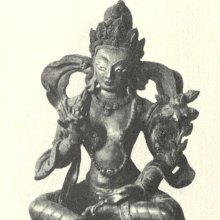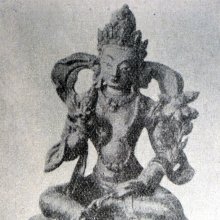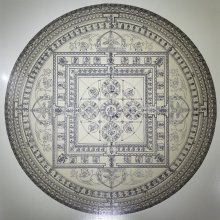Dhyanaparamita, Dhyānapāramitā, Dhyana-paramita: 7 definitions
Introduction:
Dhyanaparamita means something in Buddhism, Pali, Hinduism, Sanskrit. If you want to know the exact meaning, history, etymology or English translation of this term then check out the descriptions on this page. Add your comment or reference to a book if you want to contribute to this summary article.
Images (photo gallery)
In Buddhism
Mahayana (major branch of Buddhism)
Source: Wisdom Library: Maha Prajnaparamita SastraDhyānapāramitā (ध्यानपारमिता) refers to the “virtue of meditation” and represents one of the six perfections (pāramitā). How does the Bodhisattva fulfill the virtue of meditation (dhyānapāramitā)? Answer: When he obtains mastery (vaśita) over all the dhyānas of the heretics (tīrthika). Thus king Śaṅkhācārya, seated in meditation, had no in- (āna) or out- (apāna) breath. A bird came and laid her eggs in his top-knot which was in the form of a conch (śaṅkhaśikhā); the Bodhisattva remained motionless (acala) until the fledglings flew away.
Source: academia.edu: A Study and Translation of the GaganagañjaparipṛcchāDhyānapāramita (ध्यानपारमित) refers to the “perfection of meditation”, according to the Gaganagañjaparipṛcchā: the eighth chapter of the Mahāsaṃnipāta (a collection of Mahāyāna Buddhist Sūtras).—Accordingly, “How then, son of good family, does the Bodhisattva collect all qualities of the Buddha by thorough practice (yoniśas-prayoga)? [...] The meditation is the cause of happiness and noble birth; the Bodhisattva completes the accumulations for peaceful meditation with happiness and noble birth; he, having transferred the accumulations of peaceful meditation into omniscience, fulfils the perfection of meditation (dhyānapāramita). [...]”.

Mahayana (महायान, mahāyāna) is a major branch of Buddhism focusing on the path of a Bodhisattva (spiritual aspirants/ enlightened beings). Extant literature is vast and primarely composed in the Sanskrit language. There are many sūtras of which some of the earliest are the various Prajñāpāramitā sūtras.
Tibetan Buddhism (Vajrayana or tantric Buddhism)
Source: archive.org: The Indian Buddhist IconographyDhyānapāramitā (ध्यानपारमिता) refers to one of twelve Pāramitā Goddesses in human form, as commonly depicted in Buddhist Iconography, and mentioned in the 11th-century Niṣpannayogāvalī of Mahāpaṇḍita Abhayākara.—Her Colour is sky-blue; her Symbol is a white lotus; she has two arms.
Dhyānapāramitā is described in the Niṣpannayogāvalī (dharmadhātuvāgīśvara-maṇḍala) as follows:—
“Dhyānapāramitā is of sky colour and holds in her left hand the white lotus”.
[The right hand as usual carries the cintāmaṇi banner. A statuette of this goddess is found in China.
The twelve deities collectively have their spiritual father in Ratnasambhava. [...] According to a statement in the maṇḍala all the deities [viz., Dhyānapāramitā] are two-armed, and they hold in the right hand the flag marked with the Cintāmaṇi jewel, and in the left their special symbols. Prajñāpāramitā is an exception since she has two more hands.]

Tibetan Buddhism includes schools such as Nyingma, Kadampa, Kagyu and Gelug. Their primary canon of literature is divided in two broad categories: The Kangyur, which consists of Buddha’s words, and the Tengyur, which includes commentaries from various sources. Esotericism and tantra techniques (vajrayāna) are collected indepently.
General definition (in Buddhism)
Source: Wisdom Library: Dharma-samgrahaDhyānapāramitā (ध्यानपारमिता) or simply dhyāna refers to the “perfection of meditation” and represents the fifth of the “six perferctions” (ṣaṭpāramitā) as defined in the Dharma-saṃgraha (section 17). The Dharma-samgraha (Dharmasangraha) is an extensive glossary of Buddhist technical terms in Sanskrit (e.g., ṣaṣ-pāramitā and dhyāna-pāramitā). The work is attributed to Nagarjuna who lived around the 2nd century A.D.
Dhyānapāramitā forms, besides a part of the “six perferctions” (ṣaṭpāramitā), also a part of the “ten perfections” (daśa-pāramitā).
Languages of India and abroad
Sanskrit dictionary
Source: Cologne Digital Sanskrit Dictionaries: Monier-Williams Sanskrit-English DictionaryDhyānapāramitā (ध्यानपारमिता):—[=dhyāna-pāramitā] [from dhyāna > dhyai] f. perfection of m°, [Kāraṇḍa-vyūha; Monier-Williams’ Buddhism 128.]
[Sanskrit to German]
Sanskrit, also spelled संस्कृतम् (saṃskṛtam), is an ancient language of India commonly seen as the grandmother of the Indo-European language family (even English!). Closely allied with Prakrit and Pali, Sanskrit is more exhaustive in both grammar and terms and has the most extensive collection of literature in the world, greatly surpassing its sister-languages Greek and Latin.
See also (Relevant definitions)
Partial matches: Dhyana, Paramita.
Full-text: Shatparamita, Six Perfections, Paramita, Dashaparamita, Ten Perfections, Dhyana, Tirthika, Vasita, Shankhashikha.
Relevant text
Search found 12 books and stories containing Dhyanaparamita, Dhyānapāramitā, Dhyana-paramita, Dhyāna-pāramitā; (plurals include: Dhyanaparamitas, Dhyānapāramitās, paramitas, pāramitās). You can also click to the full overview containing English textual excerpts. Below are direct links for the most relevant articles:
The Indian Buddhist Iconography (by Benoytosh Bhattachacharyya)
Maha Prajnaparamita Sastra (by Gelongma Karma Migme Chödrön)
Part 9 - Fulfilling the perfections skillfully < [Chapter XLIX - The Four Conditions]
Definition of dhyāna and the virtue of meditation (dhyānapāramitā) < [Part 5 - The virtue of meditation]
Part 2 - Practicing the six perfections < [Chapter XLV - Application of Merit]
A Golden Ring (by Dr. Yutang Lin)
Vimalakirti Nirdesa Sutra (by Charles Luk)
Ksitigarbha Bodhisattva fundamental vow sutra (by Johnny Yu)
Prajnaparamita in Buddhist < [November-December 1931]


